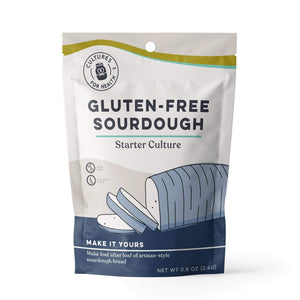
All-purpose flour is a common wheat flour in conventional baked-good recipes. It is used in everything from bread to biscuits to pie crusts and cake. Since so many recipes call for this type of flour, and it is widely sold at most supermarkets, it is a simple one-bag ingredient to keep in the pantry.
Gluten-free recipes, on the other hand, often call for three or more flours in a recipe. In order to mimic the flavor and texture of wheat flour, usually several gluten-free flours with varying properties are mixed together in a recipe to create an “all-purpose flour”.
15 minutes
45 minutes
4
INGREDIENTS AND EQUIPMENT AVAILABLE AT CULTURES FOR HEALTH
Gluten-Free Sourdough Starter

Gluten-Free Sourdough Starter Culture
$14.99
Not eating gluten? No problem! With the help of our gluten free sourdough starter culture, you can make tangy, fluffy sourdough bread that’s gluten-free.
The GF sourdough starter is an heirloom culture, meaning you'll make endless bread dough all from one starter! Just add water and gluten-free flour.
Sourdough is perfect for beginners, and this gluten free sourdough bread starter is a very forgiving culture and one of the easiest to work with.
SIMPLIFYING GLUTEN-FREE (GF) BAKING
In order to prevent the hassle of opening three or more bags of flour every time you wish to whip up a gluten-free recipe, you may find it helpful to mix a large quantity of GF all-purpose flour together. You’ll only need to open all five bags one time to mix up a huge batch of flour, and then when you want to put a recipe together you can just pull out a single bag or jar.
This particular GF flour blend is meant to mimic a bag of white, all-purpose, wheat flour. Much of the flour in this recipe is made up of starch and binding flours which create baked goods with a lighter texture. It can, therefore, be used to replace flour blends with a similar “white flour” characteristic in gluten-free recipes of all kinds.
CUSTOMIZING WITH YOUR BINDER
The downfall of creating an all-purpose blend is that it will not be customized for the ideal loaf of sandwich bread or the tender pie crust. These are on the opposite ends of the baked-goods spectrum, as bread generally needs more elasticity and binding whereas pie crusts are meant to remain tender and flaky. So while using an all-purpose blend will generally produce good results, you may find that fine tuning your flour mixture for specific types of baked goods – namely bread loaves or pastries – will generate a better outcome.
Most gluten-free recipes will also call for a specific amount and type of binder, which is often determined by the type of baked good. This particular recipe gives a measurement for xanthan gum, but it is listed as optional. Xanthan gum is used to mimic the gluten property of wheat flour. It is generally needed in larger quantities for high-rising yeast breads and in smaller quantities for tender cakes, pies, and cookies.
If you choose to leave out the xanthan gum, you can then customize the amount and type of binder to the recipe being made which may help resolve the issues with flour customization mentioned above.
INGREDIENTS:
- 1 cup brown rice flour
- 1 cup sorghum flour
- 1 cup sweet rice flour
- 1/3 cup tapioca flour/starch
- 2/3 cup potato starch
- Heaping 1/2 Tbsp. xanthan gum (optional)
INSTRUCTIONS:
- Combine all of the ingredients in a large mixing bowl.
- Whisk well for five minutes in order to distribute the flours evenly.
- Move flour mixture to an airtight container for storage.
RECIPE NOTES
Multiply this recipe by the quantity you wish to have on hand. Just be sure to keep the ratios the same.















